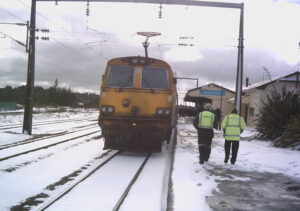1902: Waimarino County
December 24, 2024
By AHNZ
 Waimarino County came into existence by its own Act of Parliament on 2 October, 1902. The Waimarino block, located at the foot of Mount Ruapehu, had enough settlers to have transitioned from Settler frontier, to Road Board, to County. By 1918 they had their own County Offices at the County Seat of Raetihi but it was destroyed in a disastrous fire of 18-19 March that year with 120 houses and more than 60 commercial buildings. In 1922 the Council Office was rebuilt (image, left.) Fire was not going to defeat this County. However, during The Great Amalgamation of 1989 did end Waimarino when it was stitched together with others to form Ruapehu District Council¹ at the command of Big Government.
Waimarino County came into existence by its own Act of Parliament on 2 October, 1902. The Waimarino block, located at the foot of Mount Ruapehu, had enough settlers to have transitioned from Settler frontier, to Road Board, to County. By 1918 they had their own County Offices at the County Seat of Raetihi but it was destroyed in a disastrous fire of 18-19 March that year with 120 houses and more than 60 commercial buildings. In 1922 the Council Office was rebuilt (image, left.) Fire was not going to defeat this County. However, during The Great Amalgamation of 1989 did end Waimarino when it was stitched together with others to form Ruapehu District Council¹ at the command of Big Government.
Waimarino County Council requested that the railway station at National Park please not be named “Waimarino.” It was causing confusion and was at odds with the common use place names of the people who lived there. This was granted on 2 May 1926 by New Zealand Railways and this station has been called National Park railway station ever since.
However, in 2024, some backward-looking people did try to go back to the “original” named for National Park station when it opened on 9 November 1908. This failed. But, National Park Village is now to be called Waimarino. This is rather an insult to greater Waimarino and the more localised Waimarino 50km down the road. Why would they do this? My answer is that it’s yet another example of Aotearoa New Zealand Culture: A temporary fad to Maori-up any and all things, often made-up names, no matter how little sense it makes. For example, in the same era of Wokery, also in Taranaki but further west, Maxwell was re-named as Pakaraka even though there is already a Pakaraka just 1.4km down the road. Ref. 1868: Maxwell Falls, AHNZ
The loss of Waimarino County is about 40 years ago now so that you would need to be an elder GenX or older to remember it. During that time the locals have undergone sufficient cultural amnesia to be prevailed upon to give up their territorial name to the tourist village. Few Waimarino Millennials, Zoomers, on down, would even know that they had such an identity to be appropriated nor that they were once self-governing at the local level. By contrast, another Taranaki town to the west, Whangamomona, had such clear ideas in 1989 that they guarded their autonomy by becoming an independent nation! Ref. 1989: The Republic of Whangamomona, AHNZ
“This building was built to replace the former Waimarino County Council offices, burned down during the disastrous fire of 18-19 March, 1918, together with one hundred and twenty houses and more than sixty commercial and industrial buildings.” – Heritage New Zealand
“The Waimarino County is hereby constituted, and shall comprise all that portion of the Wanganui County, already constituted under “The Counties Act, 1886,” particularly described in the Schedule hereto; and the boundaries of the Wanganui County are hereby altered accordingly.” – Waimarino County Act 1902, NZLII
“National Parks had become a new fad in the West and following USA, Australia, and Canada this 4th “National Park” allowed the Native Minister, John Ballance, to feather his accomplishments just in time for…..you guessed it…..the General Election of 1887² just 3 days after the signing! So many bribes in our election history…” – 1887: Tongariro National Park, AHNZ
“Taihape shearer Reuben Alabaster, aged 19, will be first out of the blocks with his attempt on Tuesday at Te Pa Station, 859 Oruakukuru Road, Waimarino, in a wilderness south of Raetihi and Ohakune.” – NZ Herald (2022)
“An iwi bid to have the central North Island village of National Park renamed Waimarino has been successful. A second iwi proposal to change the name of the village railway station from National Park Station to Waimarino Railway Station has been declined.” – NZ Herald (19/12/2024)
“Doesn’t make sense as Waimarino has always been at Ohotu road through the Paraparas.” – Jason Rees, Facebook (2024)
“National Park Village is a town. Waimarino is any and everywhere.” – Ian Ferguson, ibid
“Originally the town was known as Waimarino (calm waters). In 1926, the New Zealand Railways renamed the railway station as National Park. This was to avoid confusion with other Waimarino entities, and also the name had come into common usage from its location close to Tongariro National Park.” – Wiki
 National Park Village (now Waimarino) might have decided to go along with the rebranding for commercial reasons. For example, the Z petrol stations have also started a Maori rebranding exercise of their stations. They’ve even gone so far as to say that this is “correct” so that by implication place names that are not Maorified are “incorrect.” Ref. RNZ (23/12/2024)
National Park Village (now Waimarino) might have decided to go along with the rebranding for commercial reasons. For example, the Z petrol stations have also started a Maori rebranding exercise of their stations. They’ve even gone so far as to say that this is “correct” so that by implication place names that are not Maorified are “incorrect.” Ref. RNZ (23/12/2024)
I wonder how well people making these changes understand their history.
For example, 2024 was also the year that the Labour Party strenuously objected to the new replacement plan for the inter-island ferries long before such a plan was even revealed. Likewise, there was massive protest toward the ACT Party’s Treaty Principles Bill even while no content of the proposed legislation had been released. In these ‘Feels over Reals’ times people don’t let knowing what they’re talking about get in the way of having a strong opinion.
“I suppose having your original name over 900years changed is whats considered pushy.” said one Susan Blackburn on Facebook. It wouldn’t occur to most people that Waimarino Railway Station was not authentic but rather an instance of Crown Colony Affirmative Action. The only people who really connected with this place as Waimarino were probably only the itinerant railway workers who built the place in those early years.
This re-naming fad will pass and look silly by the 2030s. However, by then much culture will have been changed or censored or cancelled and never stood up again. Anything you can think of is under attack unless it conforms to the Current Thing. Replacements don’t need to be authentic, just authentic-presenting. As above, they can simply steal an existing name even though it’s in use. Or, simply make one up from scratch. As Auckland Council phrased it: “a contemporary name that reflects a historical activity of the area prior to European settlement or the name may have an environmental connection.” Ref. Stuff (2023)
Thus, historical names with real connection to people are cancelled in favour of often totally invented ones with absolutely no heritage value. Only the New Zealand culture with very strong roots will not be blown away. Though it is pretended to be about “correction” of history I wish we could just be honest about what’s going on here. It’s all about political hegemony by people with nothing much else to do than write entitled letter to the Geographic Board. And, at the expense of people employed with busy lives to lead.
—
Image ref. Wiki
Image ref. National Park Station, AHNZ Archives (2008)
1 Having briefly been Waimarino District
 Like Comment Share
Like Comment Share





